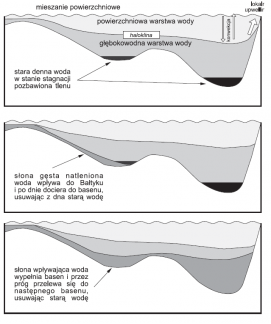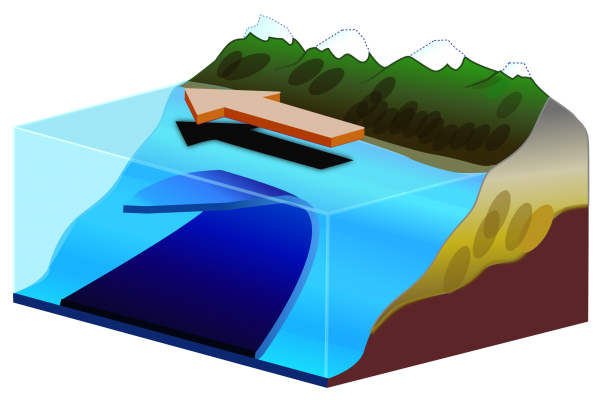
Hydrology of the Baltic Sea
Hydrology of the Baltic
SALINITY
Salinity can be simply described as the amount of salt in 1 kg of sea water. It used to be expressed in per mille, later replaced by PSU (Practical Salinity Unit).
Based on the history of the formation of the Baltic Sea, we know that this basin was a lake several times and if it were cut off from the ocean today, it would again become a freshwater reservoir. The reason for this is the positive water balance of the Baltic Sea, which is the result of the predominance of fresh water inflow over evaporation. A constant supply of fresh water is ensured primarily by numerous rivers and rainfall.
The average salinity of oceans amounts to approx. 35 PSU, whereas the average salinity of the Baltic is almost 5 times lower and amounts to 7.5 PSU. The salinity varies across the Baltic and decreases gradually northwards, further away from the Danish straits. The surface water layer is less salty than the bottom layer, also characterized by higher density.
INFLOWS and STRATIFICATION
The positive water balance of the Baltic makes its waters flow towards the North Sea. However, periodically, as a result of the impact of strong western winds and raising of water level in the North Sea, the direction of water flow changes. Thus, in such a situation, inflows occur and their size depends on environmental and weather conditions.
Due to the fact that water flowing to the Baltic during the inflow is more salty and dense, it sinks to the bottom, filling the deeper parts. Stratification of water is characteristic for the Baltic. It consists of two layers with different salinity and density, separated by the so-called halocline. In the western part of the Baltic, halocline is formed at the depth of 40-60 m, and in the eastern part at 60-80 m.
Mixing of waters in the Baltic takes place during winter storms and periodic vertical convection (the phenomenon consisting of cooling of surface water in autumn-winter season and then falling to the bottom), which only covers the layer of water from the surface to the halocline. An exception to this rule is the Bothnian Sea, where the salinity is much lower and convection reaches the bottom. The lack of mixing of waters in the Baltic Proper causes many problems. The water inflowing from the North Sea is more saline and contains oxygen, which might be missing below the halocline. Dead zone, hypoxia (low oxygen level) or anoxia (no oxygen) occur when the oxygen dissolved in water is used up and there are no inflows. Toxic hydrogen sulphide is formed at the sea bottom under the anoxic conditions.
UPWELLING
Upwelling is a phenomenon well known to all Baltic lovers, even if they do not know its mechanisms. Many people experienced an unpleasant surprise caused by cold water near the shore. This is due to upwelling leading to a strong sea-surface temperature drop of more than 10 °C. Upwelling is caused by winds blowing predominately parallel to the coast cause upwelling leading to vertical displacement of the water body and mixing.
Upwelling occurs when winds blowing along the shore from north-east to south-east cause surface water to flow away from the shore towards the open sea. In place of the waters "pushed" from the shore, cold waters flow from the bottom, from under the thermocline, i.e. the temperature jump layer. This phenomenon disappears when the wind direction changes.



